Analyzing the Challenges and Opportunities in the Food Industry
VerifiedAdded on 2023/06/08
|11
|1637
|343
Report
AI Summary
This report delves into the challenges and opportunities within the food industry, utilizing secondary data to provide a comprehensive overview. It highlights the industry's profitability and growth, examining its size and the competitive landscape through Porter's Five Forces. Key drivers and barriers, including government policies, international agreements, technological advancements, and customer preferences, are discussed. The report identifies opportunities such as technological innovation and threats like rising costs and the grey market. Recommendations include continuous product innovation and a focus on sustainability, suggesting that larger food companies should incubate smaller businesses to foster industry growth. Desklib provides access to this report and other study resources.
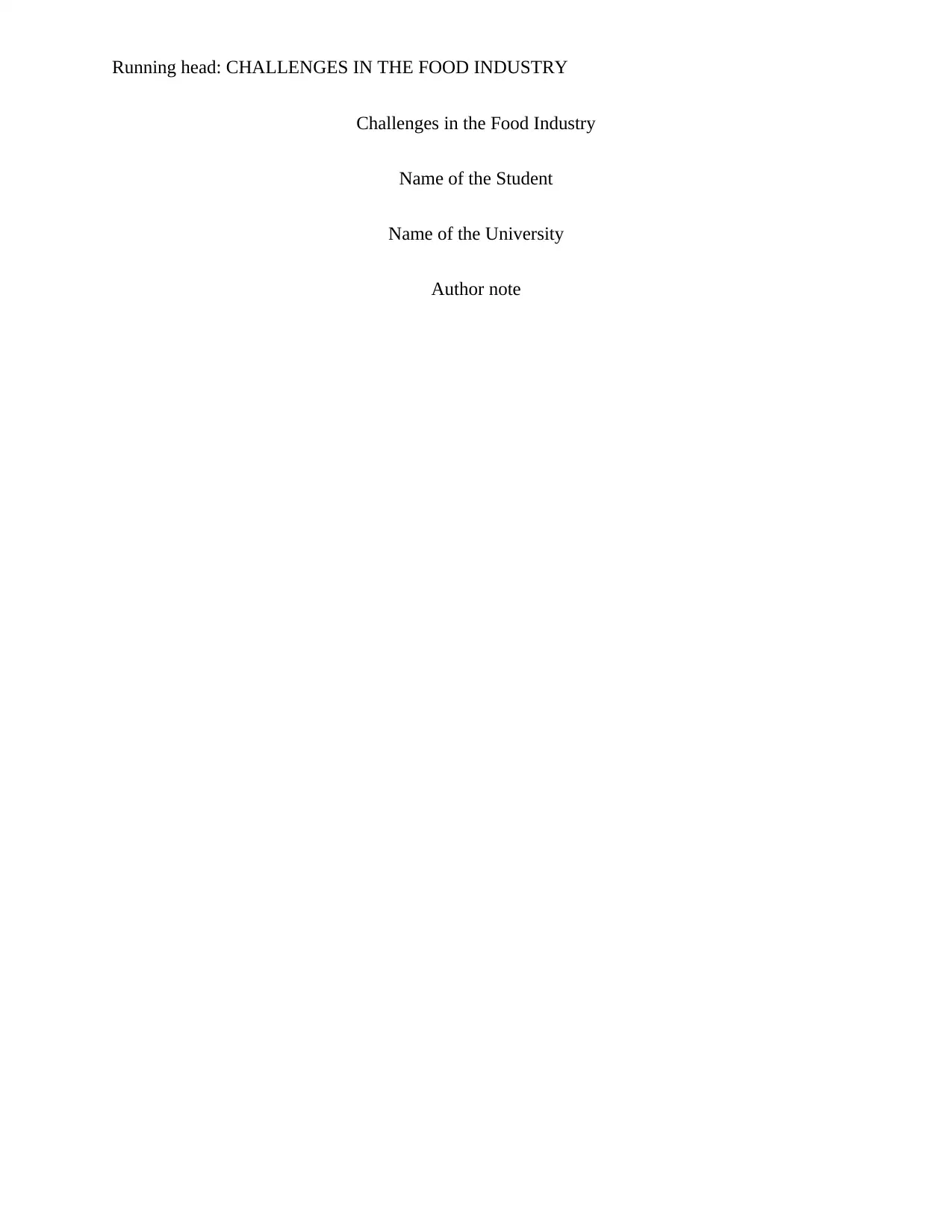
Running head: CHALLENGES IN THE FOOD INDUSTRY
Challenges in the Food Industry
Name of the Student
Name of the University
Author note
Challenges in the Food Industry
Name of the Student
Name of the University
Author note
Paraphrase This Document
Need a fresh take? Get an instant paraphrase of this document with our AI Paraphraser
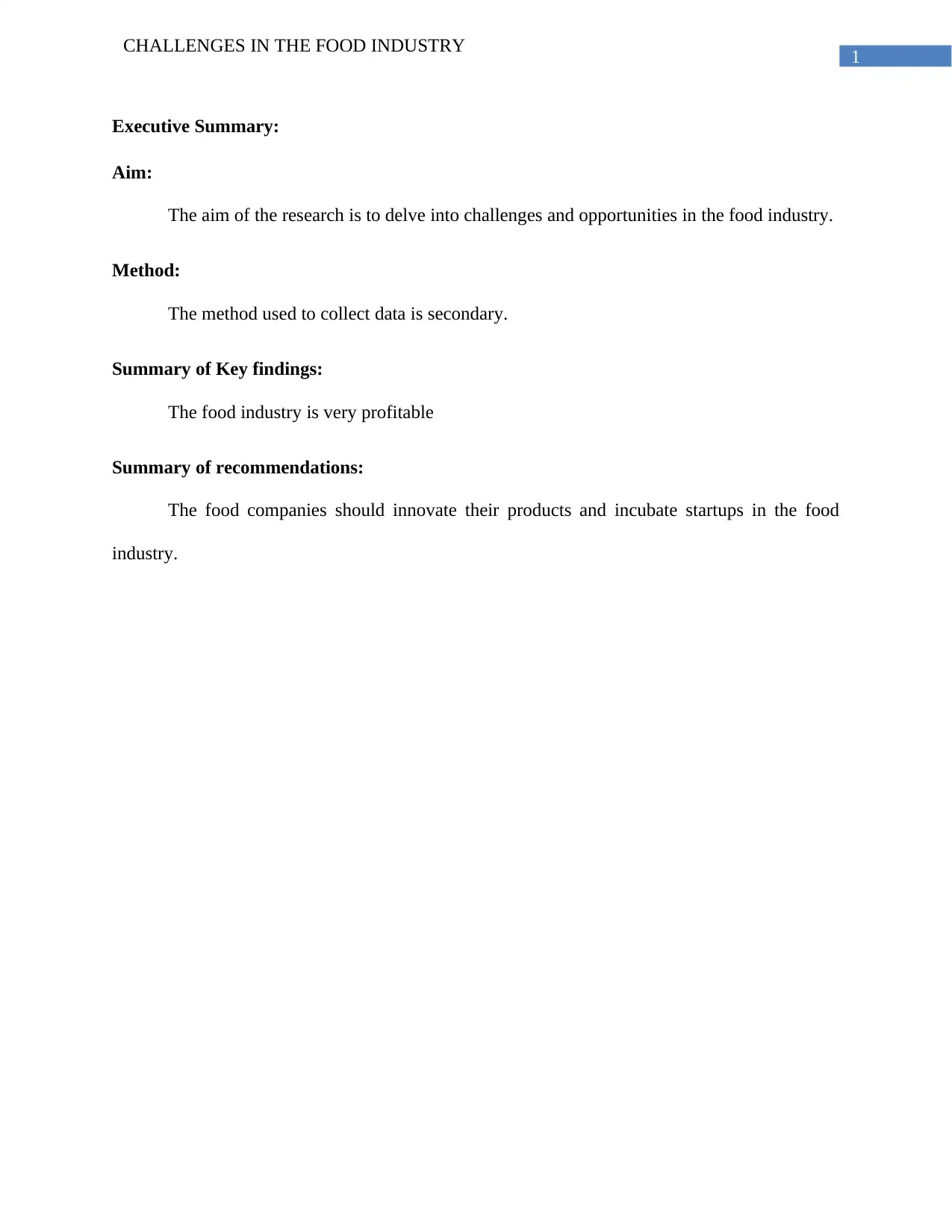
1
CHALLENGES IN THE FOOD INDUSTRY
Executive Summary:
Aim:
The aim of the research is to delve into challenges and opportunities in the food industry.
Method:
The method used to collect data is secondary.
Summary of Key findings:
The food industry is very profitable
Summary of recommendations:
The food companies should innovate their products and incubate startups in the food
industry.
CHALLENGES IN THE FOOD INDUSTRY
Executive Summary:
Aim:
The aim of the research is to delve into challenges and opportunities in the food industry.
Method:
The method used to collect data is secondary.
Summary of Key findings:
The food industry is very profitable
Summary of recommendations:
The food companies should innovate their products and incubate startups in the food
industry.
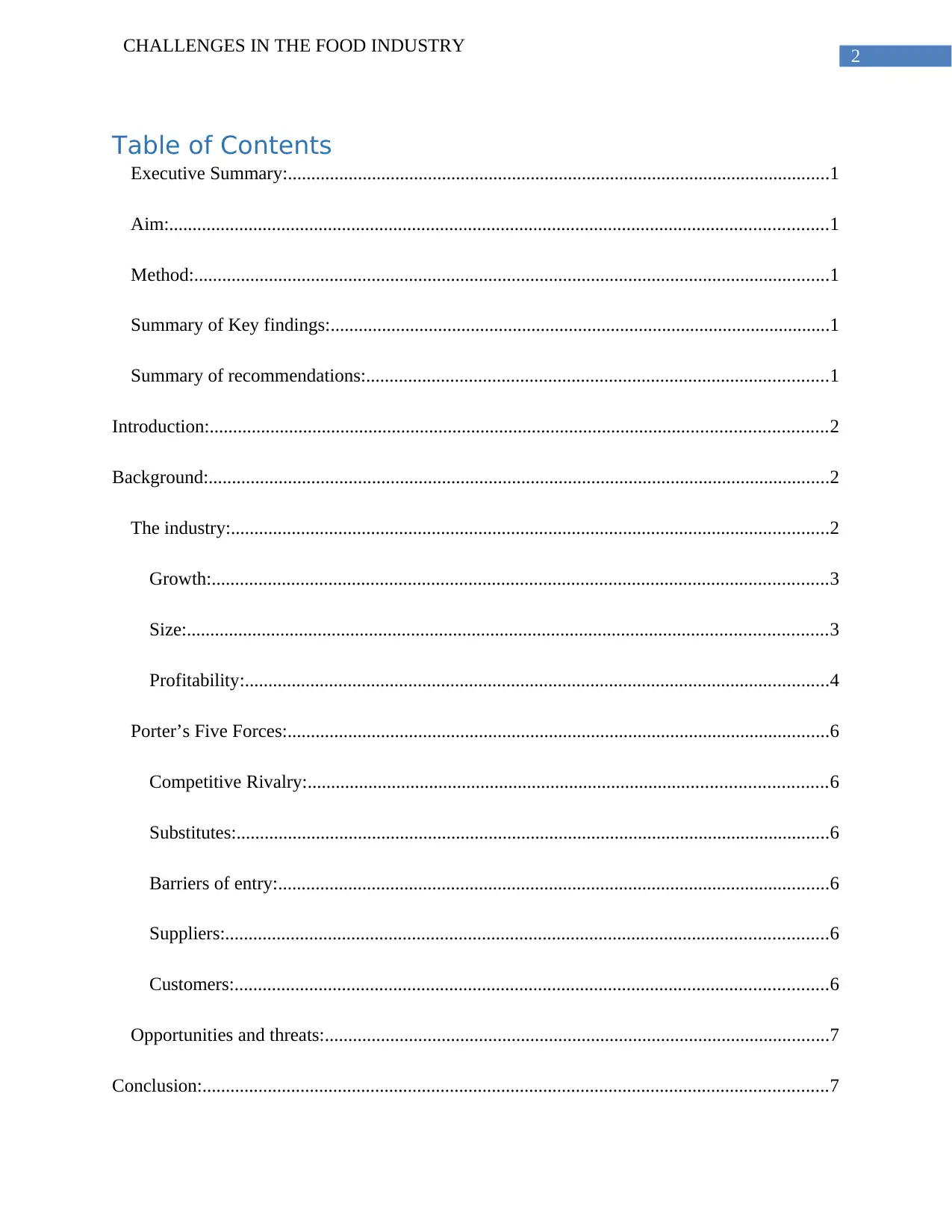
2
CHALLENGES IN THE FOOD INDUSTRY
Table of Contents
Executive Summary:....................................................................................................................1
Aim:.............................................................................................................................................1
Method:........................................................................................................................................1
Summary of Key findings:...........................................................................................................1
Summary of recommendations:...................................................................................................1
Introduction:....................................................................................................................................2
Background:.....................................................................................................................................2
The industry:................................................................................................................................2
Growth:....................................................................................................................................3
Size:.........................................................................................................................................3
Profitability:.............................................................................................................................4
Porter’s Five Forces:....................................................................................................................6
Competitive Rivalry:...............................................................................................................6
Substitutes:...............................................................................................................................6
Barriers of entry:......................................................................................................................6
Suppliers:.................................................................................................................................6
Customers:...............................................................................................................................6
Opportunities and threats:............................................................................................................7
Conclusion:......................................................................................................................................7
CHALLENGES IN THE FOOD INDUSTRY
Table of Contents
Executive Summary:....................................................................................................................1
Aim:.............................................................................................................................................1
Method:........................................................................................................................................1
Summary of Key findings:...........................................................................................................1
Summary of recommendations:...................................................................................................1
Introduction:....................................................................................................................................2
Background:.....................................................................................................................................2
The industry:................................................................................................................................2
Growth:....................................................................................................................................3
Size:.........................................................................................................................................3
Profitability:.............................................................................................................................4
Porter’s Five Forces:....................................................................................................................6
Competitive Rivalry:...............................................................................................................6
Substitutes:...............................................................................................................................6
Barriers of entry:......................................................................................................................6
Suppliers:.................................................................................................................................6
Customers:...............................................................................................................................6
Opportunities and threats:............................................................................................................7
Conclusion:......................................................................................................................................7
⊘ This is a preview!⊘
Do you want full access?
Subscribe today to unlock all pages.

Trusted by 1+ million students worldwide

3
CHALLENGES IN THE FOOD INDUSTRY
Recommendations:..........................................................................................................................7
References:......................................................................................................................................8
CHALLENGES IN THE FOOD INDUSTRY
Recommendations:..........................................................................................................................7
References:......................................................................................................................................8
Paraphrase This Document
Need a fresh take? Get an instant paraphrase of this document with our AI Paraphraser
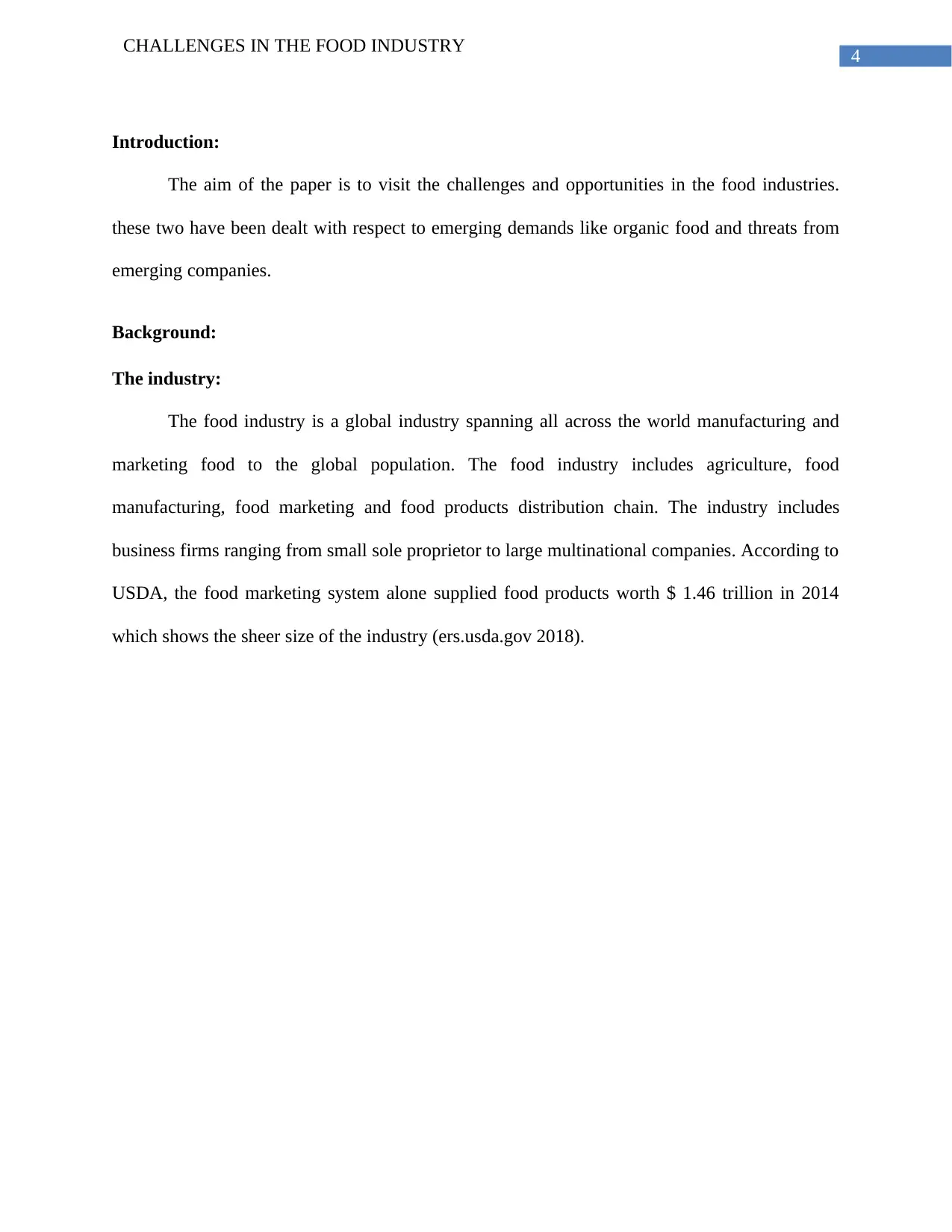
4
CHALLENGES IN THE FOOD INDUSTRY
Introduction:
The aim of the paper is to visit the challenges and opportunities in the food industries.
these two have been dealt with respect to emerging demands like organic food and threats from
emerging companies.
Background:
The industry:
The food industry is a global industry spanning all across the world manufacturing and
marketing food to the global population. The food industry includes agriculture, food
manufacturing, food marketing and food products distribution chain. The industry includes
business firms ranging from small sole proprietor to large multinational companies. According to
USDA, the food marketing system alone supplied food products worth $ 1.46 trillion in 2014
which shows the sheer size of the industry (ers.usda.gov 2018).
CHALLENGES IN THE FOOD INDUSTRY
Introduction:
The aim of the paper is to visit the challenges and opportunities in the food industries.
these two have been dealt with respect to emerging demands like organic food and threats from
emerging companies.
Background:
The industry:
The food industry is a global industry spanning all across the world manufacturing and
marketing food to the global population. The food industry includes agriculture, food
manufacturing, food marketing and food products distribution chain. The industry includes
business firms ranging from small sole proprietor to large multinational companies. According to
USDA, the food marketing system alone supplied food products worth $ 1.46 trillion in 2014
which shows the sheer size of the industry (ers.usda.gov 2018).
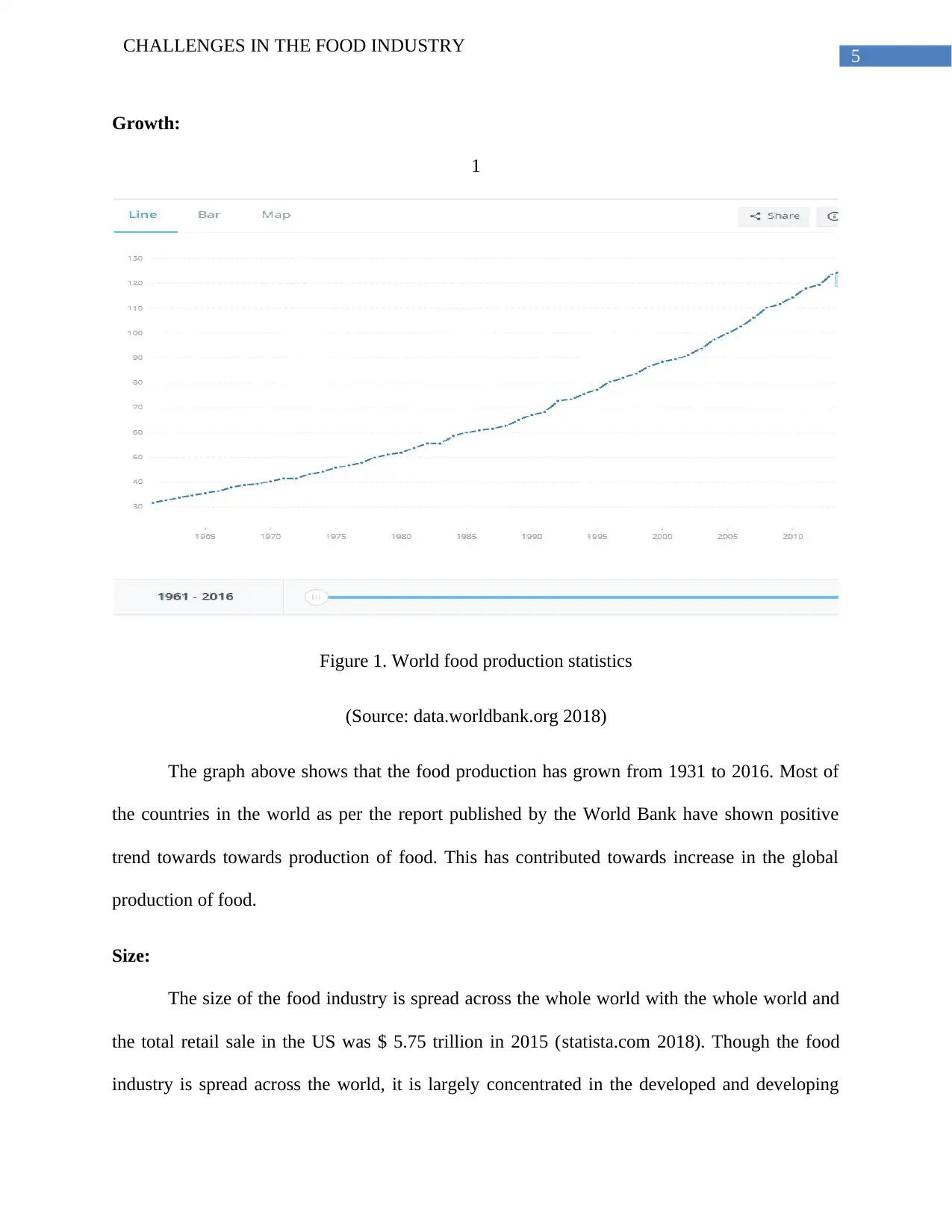
5
CHALLENGES IN THE FOOD INDUSTRY
Growth:
1
Figure 1. World food production statistics
(Source: data.worldbank.org 2018)
The graph above shows that the food production has grown from 1931 to 2016. Most of
the countries in the world as per the report published by the World Bank have shown positive
trend towards towards production of food. This has contributed towards increase in the global
production of food.
Size:
The size of the food industry is spread across the whole world with the whole world and
the total retail sale in the US was $ 5.75 trillion in 2015 (statista.com 2018). Though the food
industry is spread across the world, it is largely concentrated in the developed and developing
CHALLENGES IN THE FOOD INDUSTRY
Growth:
1
Figure 1. World food production statistics
(Source: data.worldbank.org 2018)
The graph above shows that the food production has grown from 1931 to 2016. Most of
the countries in the world as per the report published by the World Bank have shown positive
trend towards towards production of food. This has contributed towards increase in the global
production of food.
Size:
The size of the food industry is spread across the whole world with the whole world and
the total retail sale in the US was $ 5.75 trillion in 2015 (statista.com 2018). Though the food
industry is spread across the world, it is largely concentrated in the developed and developing
⊘ This is a preview!⊘
Do you want full access?
Subscribe today to unlock all pages.

Trusted by 1+ million students worldwide
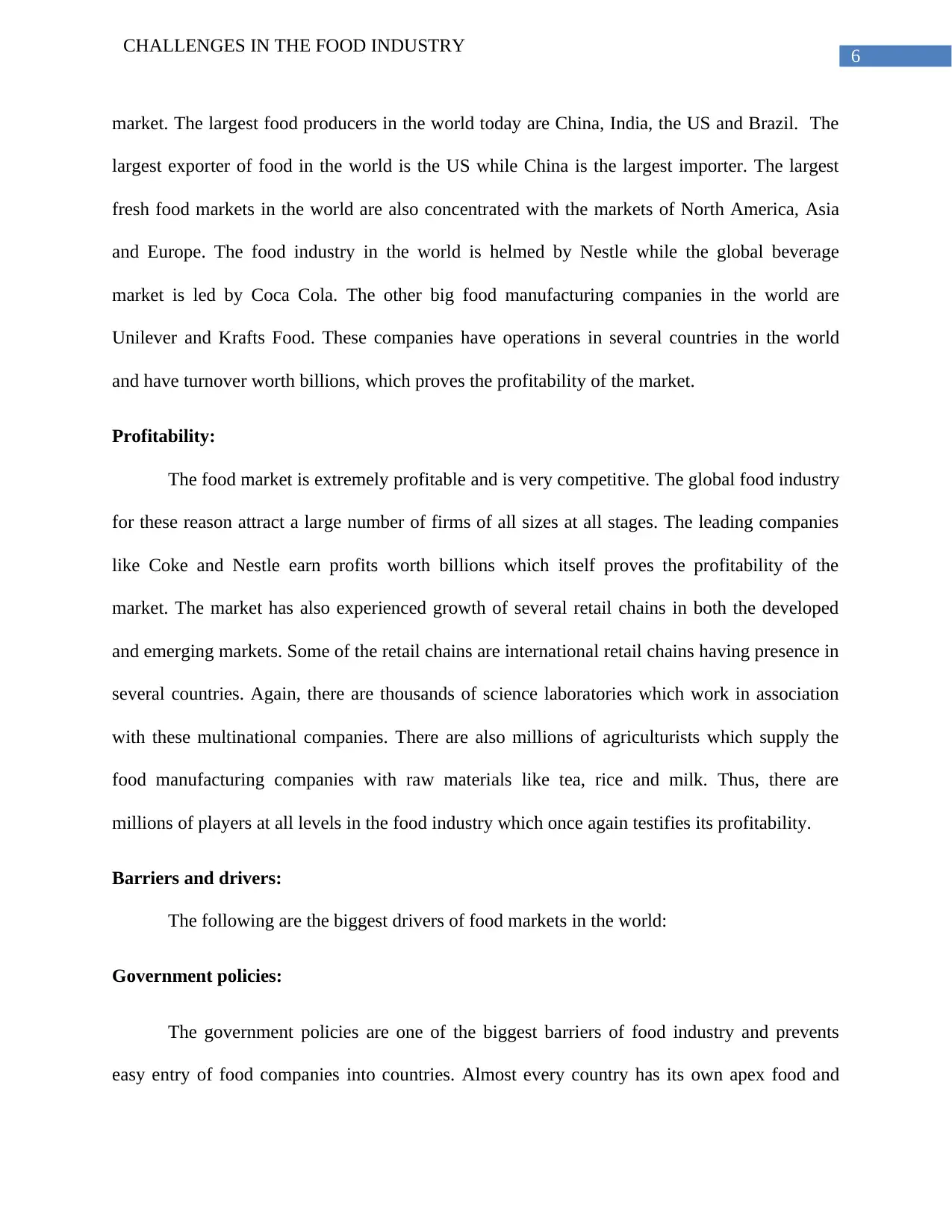
6
CHALLENGES IN THE FOOD INDUSTRY
market. The largest food producers in the world today are China, India, the US and Brazil. The
largest exporter of food in the world is the US while China is the largest importer. The largest
fresh food markets in the world are also concentrated with the markets of North America, Asia
and Europe. The food industry in the world is helmed by Nestle while the global beverage
market is led by Coca Cola. The other big food manufacturing companies in the world are
Unilever and Krafts Food. These companies have operations in several countries in the world
and have turnover worth billions, which proves the profitability of the market.
Profitability:
The food market is extremely profitable and is very competitive. The global food industry
for these reason attract a large number of firms of all sizes at all stages. The leading companies
like Coke and Nestle earn profits worth billions which itself proves the profitability of the
market. The market has also experienced growth of several retail chains in both the developed
and emerging markets. Some of the retail chains are international retail chains having presence in
several countries. Again, there are thousands of science laboratories which work in association
with these multinational companies. There are also millions of agriculturists which supply the
food manufacturing companies with raw materials like tea, rice and milk. Thus, there are
millions of players at all levels in the food industry which once again testifies its profitability.
Barriers and drivers:
The following are the biggest drivers of food markets in the world:
Government policies:
The government policies are one of the biggest barriers of food industry and prevents
easy entry of food companies into countries. Almost every country has its own apex food and
CHALLENGES IN THE FOOD INDUSTRY
market. The largest food producers in the world today are China, India, the US and Brazil. The
largest exporter of food in the world is the US while China is the largest importer. The largest
fresh food markets in the world are also concentrated with the markets of North America, Asia
and Europe. The food industry in the world is helmed by Nestle while the global beverage
market is led by Coca Cola. The other big food manufacturing companies in the world are
Unilever and Krafts Food. These companies have operations in several countries in the world
and have turnover worth billions, which proves the profitability of the market.
Profitability:
The food market is extremely profitable and is very competitive. The global food industry
for these reason attract a large number of firms of all sizes at all stages. The leading companies
like Coke and Nestle earn profits worth billions which itself proves the profitability of the
market. The market has also experienced growth of several retail chains in both the developed
and emerging markets. Some of the retail chains are international retail chains having presence in
several countries. Again, there are thousands of science laboratories which work in association
with these multinational companies. There are also millions of agriculturists which supply the
food manufacturing companies with raw materials like tea, rice and milk. Thus, there are
millions of players at all levels in the food industry which once again testifies its profitability.
Barriers and drivers:
The following are the biggest drivers of food markets in the world:
Government policies:
The government policies are one of the biggest barriers of food industry and prevents
easy entry of food companies into countries. Almost every country has its own apex food and
Paraphrase This Document
Need a fresh take? Get an instant paraphrase of this document with our AI Paraphraser
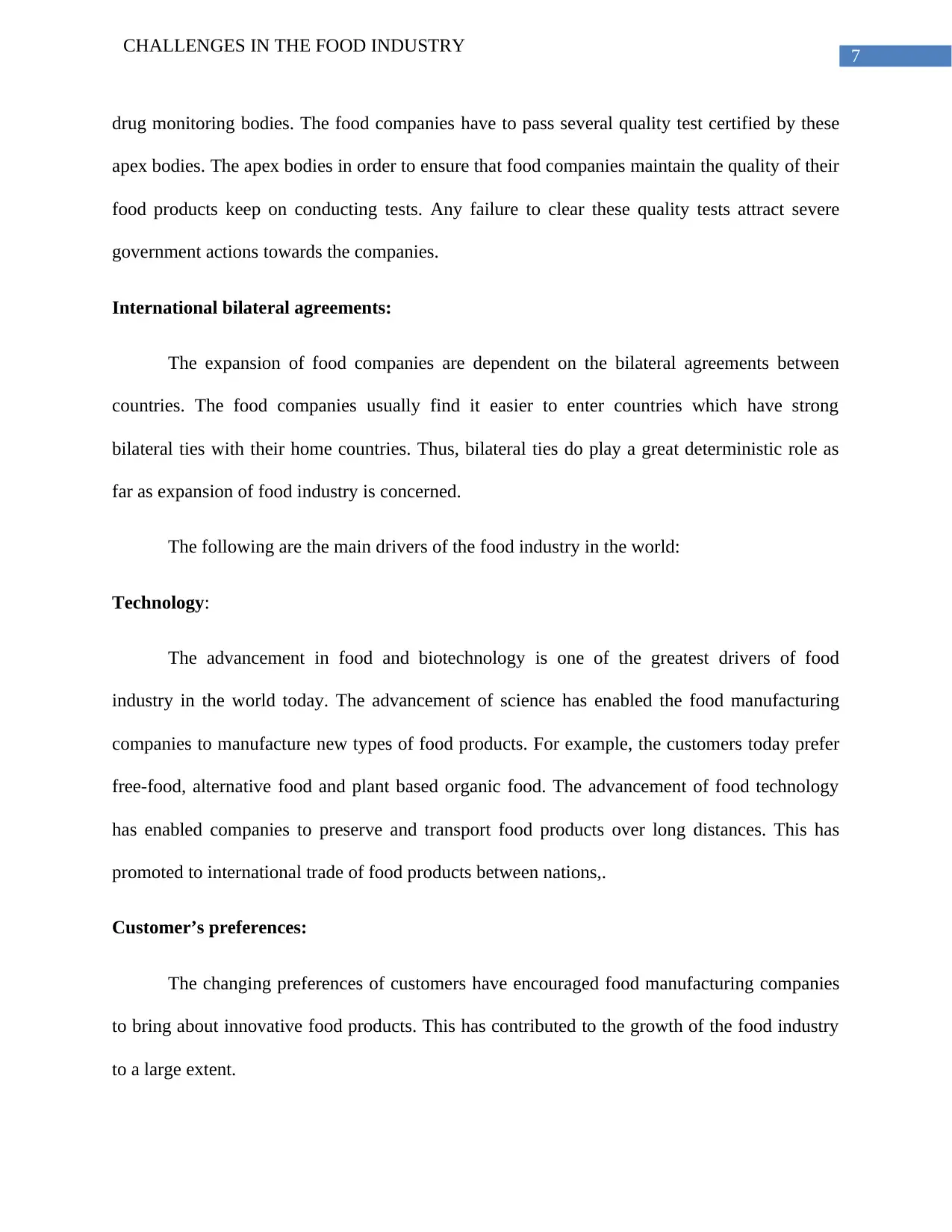
7
CHALLENGES IN THE FOOD INDUSTRY
drug monitoring bodies. The food companies have to pass several quality test certified by these
apex bodies. The apex bodies in order to ensure that food companies maintain the quality of their
food products keep on conducting tests. Any failure to clear these quality tests attract severe
government actions towards the companies.
International bilateral agreements:
The expansion of food companies are dependent on the bilateral agreements between
countries. The food companies usually find it easier to enter countries which have strong
bilateral ties with their home countries. Thus, bilateral ties do play a great deterministic role as
far as expansion of food industry is concerned.
The following are the main drivers of the food industry in the world:
Technology:
The advancement in food and biotechnology is one of the greatest drivers of food
industry in the world today. The advancement of science has enabled the food manufacturing
companies to manufacture new types of food products. For example, the customers today prefer
free-food, alternative food and plant based organic food. The advancement of food technology
has enabled companies to preserve and transport food products over long distances. This has
promoted to international trade of food products between nations,.
Customer’s preferences:
The changing preferences of customers have encouraged food manufacturing companies
to bring about innovative food products. This has contributed to the growth of the food industry
to a large extent.
CHALLENGES IN THE FOOD INDUSTRY
drug monitoring bodies. The food companies have to pass several quality test certified by these
apex bodies. The apex bodies in order to ensure that food companies maintain the quality of their
food products keep on conducting tests. Any failure to clear these quality tests attract severe
government actions towards the companies.
International bilateral agreements:
The expansion of food companies are dependent on the bilateral agreements between
countries. The food companies usually find it easier to enter countries which have strong
bilateral ties with their home countries. Thus, bilateral ties do play a great deterministic role as
far as expansion of food industry is concerned.
The following are the main drivers of the food industry in the world:
Technology:
The advancement in food and biotechnology is one of the greatest drivers of food
industry in the world today. The advancement of science has enabled the food manufacturing
companies to manufacture new types of food products. For example, the customers today prefer
free-food, alternative food and plant based organic food. The advancement of food technology
has enabled companies to preserve and transport food products over long distances. This has
promoted to international trade of food products between nations,.
Customer’s preferences:
The changing preferences of customers have encouraged food manufacturing companies
to bring about innovative food products. This has contributed to the growth of the food industry
to a large extent.
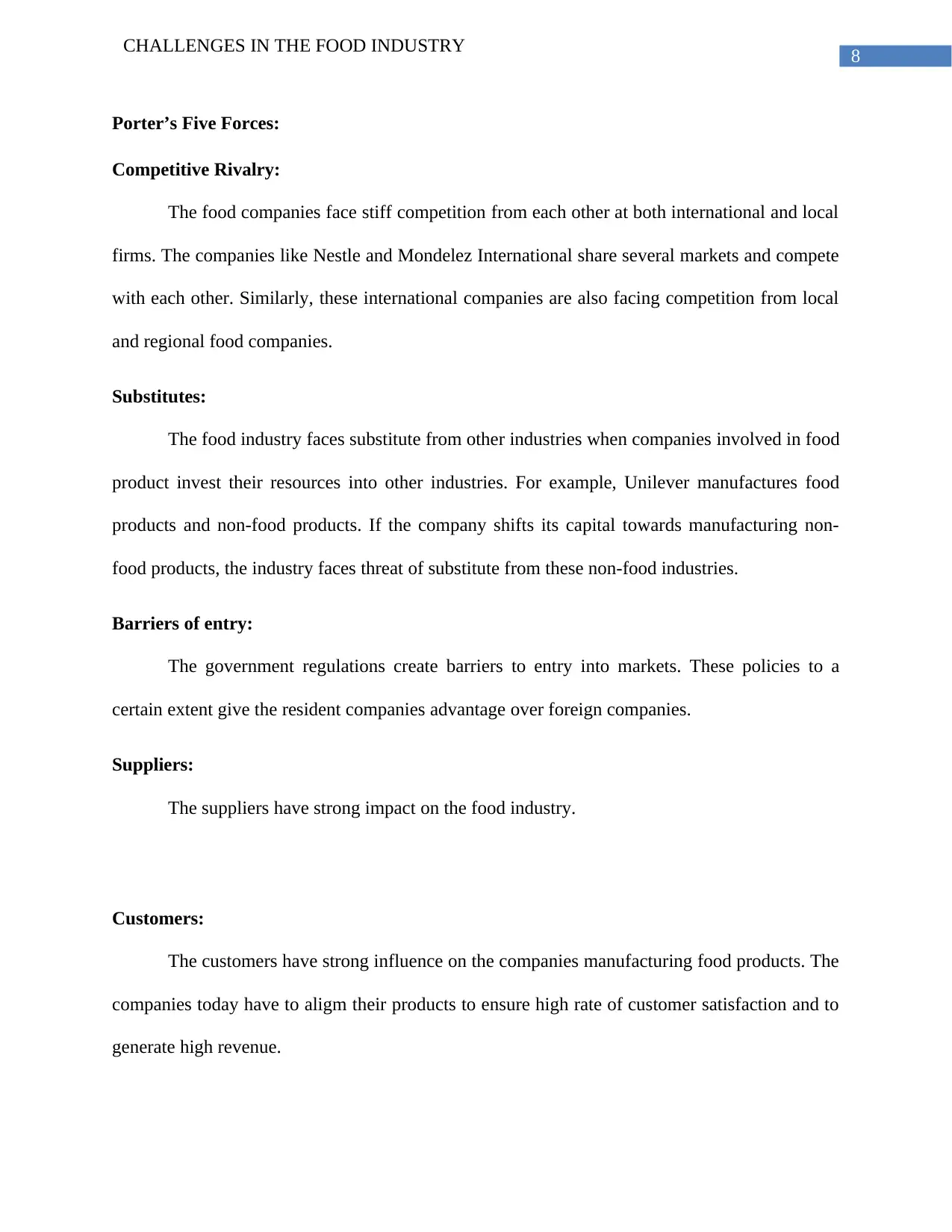
8
CHALLENGES IN THE FOOD INDUSTRY
Porter’s Five Forces:
Competitive Rivalry:
The food companies face stiff competition from each other at both international and local
firms. The companies like Nestle and Mondelez International share several markets and compete
with each other. Similarly, these international companies are also facing competition from local
and regional food companies.
Substitutes:
The food industry faces substitute from other industries when companies involved in food
product invest their resources into other industries. For example, Unilever manufactures food
products and non-food products. If the company shifts its capital towards manufacturing non-
food products, the industry faces threat of substitute from these non-food industries.
Barriers of entry:
The government regulations create barriers to entry into markets. These policies to a
certain extent give the resident companies advantage over foreign companies.
Suppliers:
The suppliers have strong impact on the food industry.
Customers:
The customers have strong influence on the companies manufacturing food products. The
companies today have to aligm their products to ensure high rate of customer satisfaction and to
generate high revenue.
CHALLENGES IN THE FOOD INDUSTRY
Porter’s Five Forces:
Competitive Rivalry:
The food companies face stiff competition from each other at both international and local
firms. The companies like Nestle and Mondelez International share several markets and compete
with each other. Similarly, these international companies are also facing competition from local
and regional food companies.
Substitutes:
The food industry faces substitute from other industries when companies involved in food
product invest their resources into other industries. For example, Unilever manufactures food
products and non-food products. If the company shifts its capital towards manufacturing non-
food products, the industry faces threat of substitute from these non-food industries.
Barriers of entry:
The government regulations create barriers to entry into markets. These policies to a
certain extent give the resident companies advantage over foreign companies.
Suppliers:
The suppliers have strong impact on the food industry.
Customers:
The customers have strong influence on the companies manufacturing food products. The
companies today have to aligm their products to ensure high rate of customer satisfaction and to
generate high revenue.
⊘ This is a preview!⊘
Do you want full access?
Subscribe today to unlock all pages.

Trusted by 1+ million students worldwide
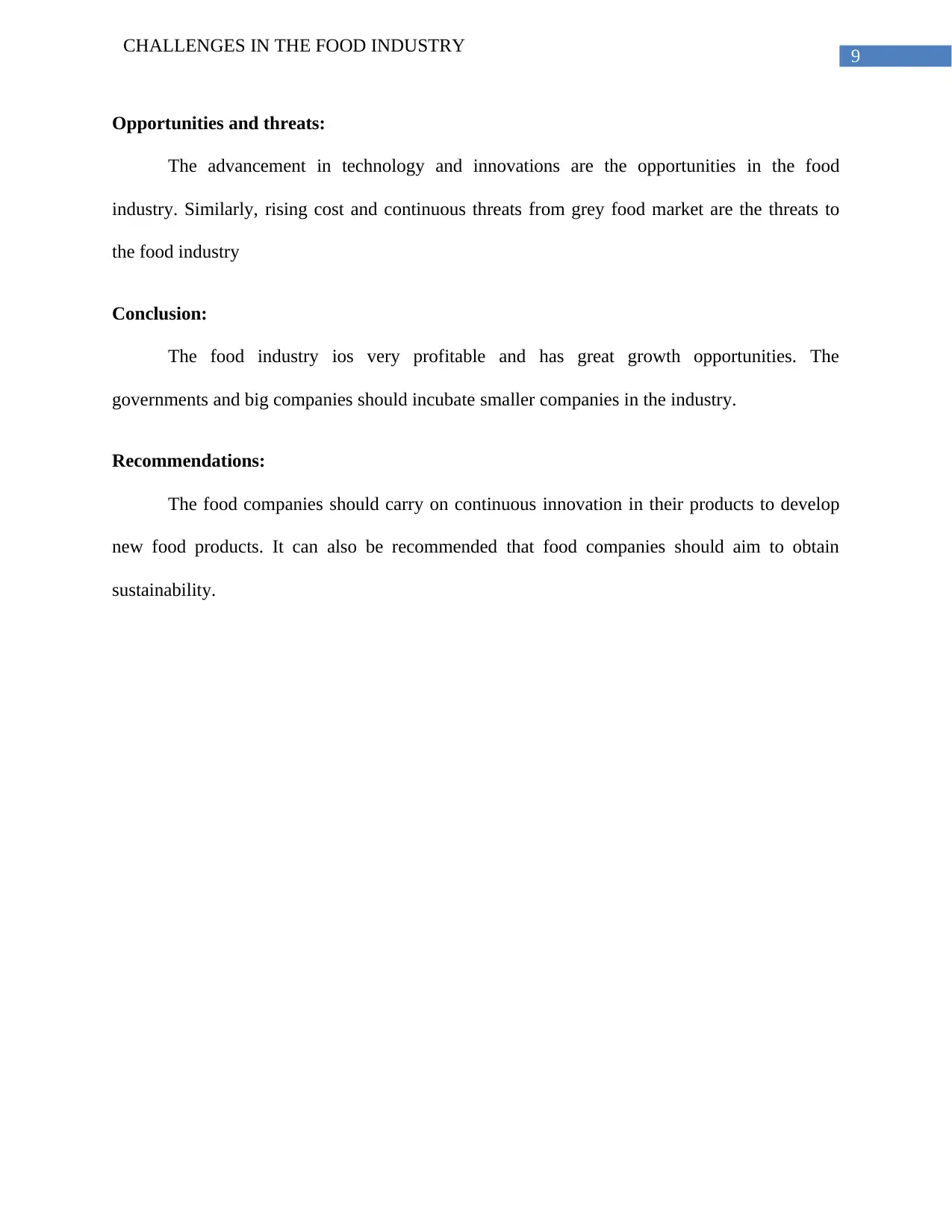
9
CHALLENGES IN THE FOOD INDUSTRY
Opportunities and threats:
The advancement in technology and innovations are the opportunities in the food
industry. Similarly, rising cost and continuous threats from grey food market are the threats to
the food industry
Conclusion:
The food industry ios very profitable and has great growth opportunities. The
governments and big companies should incubate smaller companies in the industry.
Recommendations:
The food companies should carry on continuous innovation in their products to develop
new food products. It can also be recommended that food companies should aim to obtain
sustainability.
CHALLENGES IN THE FOOD INDUSTRY
Opportunities and threats:
The advancement in technology and innovations are the opportunities in the food
industry. Similarly, rising cost and continuous threats from grey food market are the threats to
the food industry
Conclusion:
The food industry ios very profitable and has great growth opportunities. The
governments and big companies should incubate smaller companies in the industry.
Recommendations:
The food companies should carry on continuous innovation in their products to develop
new food products. It can also be recommended that food companies should aim to obtain
sustainability.
Paraphrase This Document
Need a fresh take? Get an instant paraphrase of this document with our AI Paraphraser
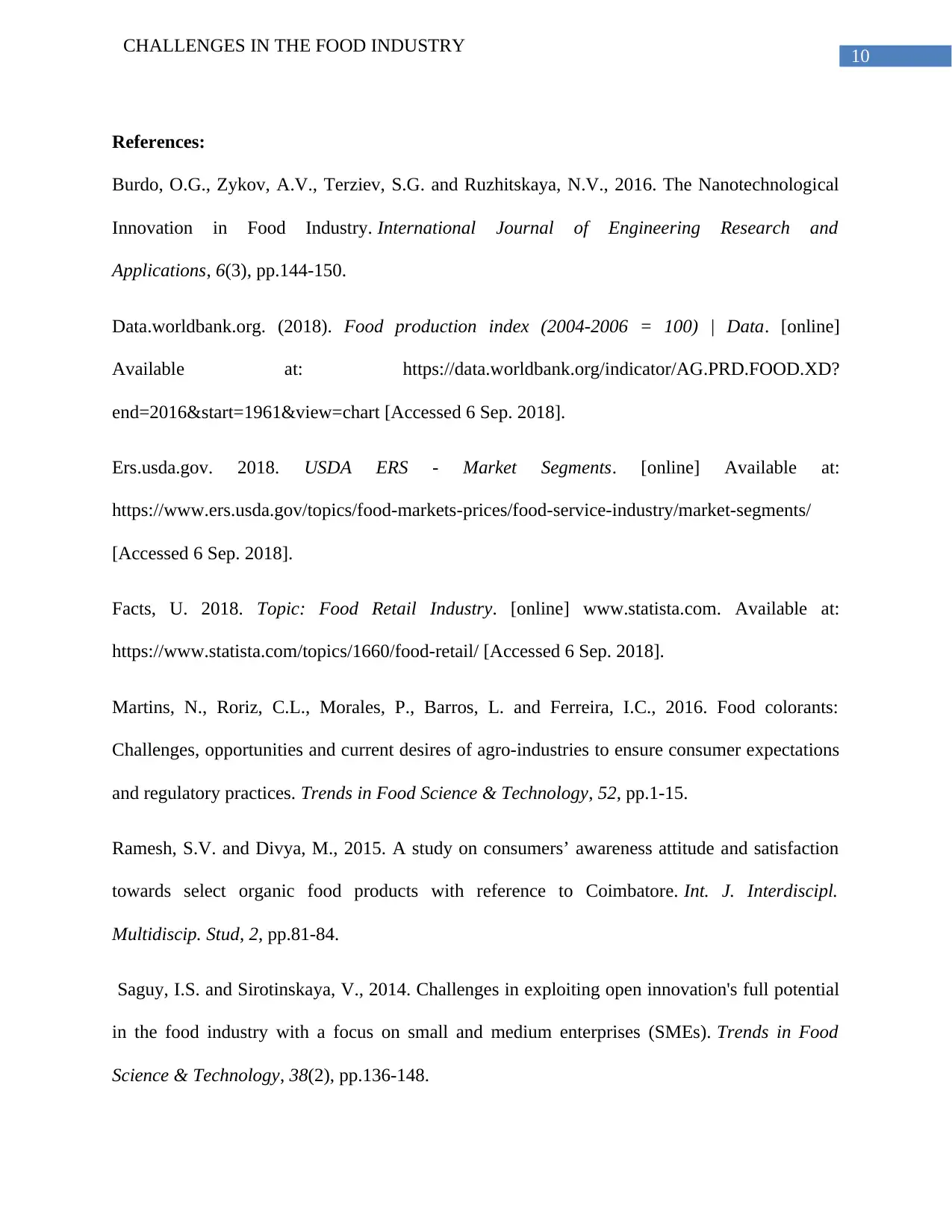
10
CHALLENGES IN THE FOOD INDUSTRY
References:
Burdo, О.G., Zykov, A.V., Terziev, S.G. and Ruzhitskaya, N.V., 2016. The Nanotechnological
Innovation in Food Industry. International Journal of Engineering Research and
Applications, 6(3), pp.144-150.
Data.worldbank.org. (2018). Food production index (2004-2006 = 100) | Data. [online]
Available at: https://data.worldbank.org/indicator/AG.PRD.FOOD.XD?
end=2016&start=1961&view=chart [Accessed 6 Sep. 2018].
Ers.usda.gov. 2018. USDA ERS - Market Segments. [online] Available at:
https://www.ers.usda.gov/topics/food-markets-prices/food-service-industry/market-segments/
[Accessed 6 Sep. 2018].
Facts, U. 2018. Topic: Food Retail Industry. [online] www.statista.com. Available at:
https://www.statista.com/topics/1660/food-retail/ [Accessed 6 Sep. 2018].
Martins, N., Roriz, C.L., Morales, P., Barros, L. and Ferreira, I.C., 2016. Food colorants:
Challenges, opportunities and current desires of agro-industries to ensure consumer expectations
and regulatory practices. Trends in Food Science & Technology, 52, pp.1-15.
Ramesh, S.V. and Divya, M., 2015. A study on consumers’ awareness attitude and satisfaction
towards select organic food products with reference to Coimbatore. Int. J. Interdiscipl.
Multidiscip. Stud, 2, pp.81-84.
Saguy, I.S. and Sirotinskaya, V., 2014. Challenges in exploiting open innovation's full potential
in the food industry with a focus on small and medium enterprises (SMEs). Trends in Food
Science & Technology, 38(2), pp.136-148.
CHALLENGES IN THE FOOD INDUSTRY
References:
Burdo, О.G., Zykov, A.V., Terziev, S.G. and Ruzhitskaya, N.V., 2016. The Nanotechnological
Innovation in Food Industry. International Journal of Engineering Research and
Applications, 6(3), pp.144-150.
Data.worldbank.org. (2018). Food production index (2004-2006 = 100) | Data. [online]
Available at: https://data.worldbank.org/indicator/AG.PRD.FOOD.XD?
end=2016&start=1961&view=chart [Accessed 6 Sep. 2018].
Ers.usda.gov. 2018. USDA ERS - Market Segments. [online] Available at:
https://www.ers.usda.gov/topics/food-markets-prices/food-service-industry/market-segments/
[Accessed 6 Sep. 2018].
Facts, U. 2018. Topic: Food Retail Industry. [online] www.statista.com. Available at:
https://www.statista.com/topics/1660/food-retail/ [Accessed 6 Sep. 2018].
Martins, N., Roriz, C.L., Morales, P., Barros, L. and Ferreira, I.C., 2016. Food colorants:
Challenges, opportunities and current desires of agro-industries to ensure consumer expectations
and regulatory practices. Trends in Food Science & Technology, 52, pp.1-15.
Ramesh, S.V. and Divya, M., 2015. A study on consumers’ awareness attitude and satisfaction
towards select organic food products with reference to Coimbatore. Int. J. Interdiscipl.
Multidiscip. Stud, 2, pp.81-84.
Saguy, I.S. and Sirotinskaya, V., 2014. Challenges in exploiting open innovation's full potential
in the food industry with a focus on small and medium enterprises (SMEs). Trends in Food
Science & Technology, 38(2), pp.136-148.
1 out of 11
Related Documents
Your All-in-One AI-Powered Toolkit for Academic Success.
+13062052269
info@desklib.com
Available 24*7 on WhatsApp / Email
![[object Object]](/_next/static/media/star-bottom.7253800d.svg)
Unlock your academic potential
Copyright © 2020–2025 A2Z Services. All Rights Reserved. Developed and managed by ZUCOL.





